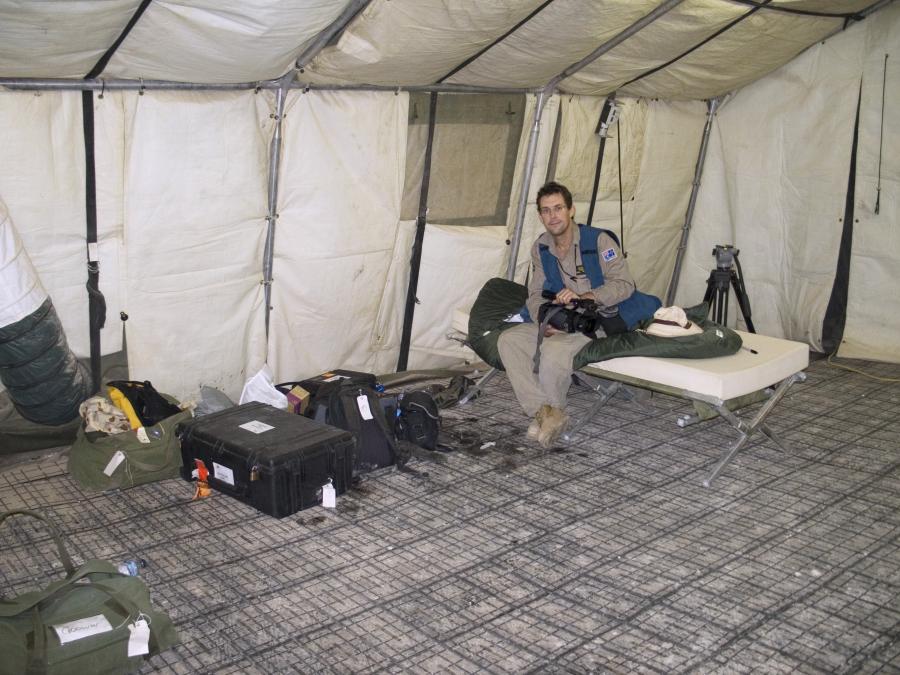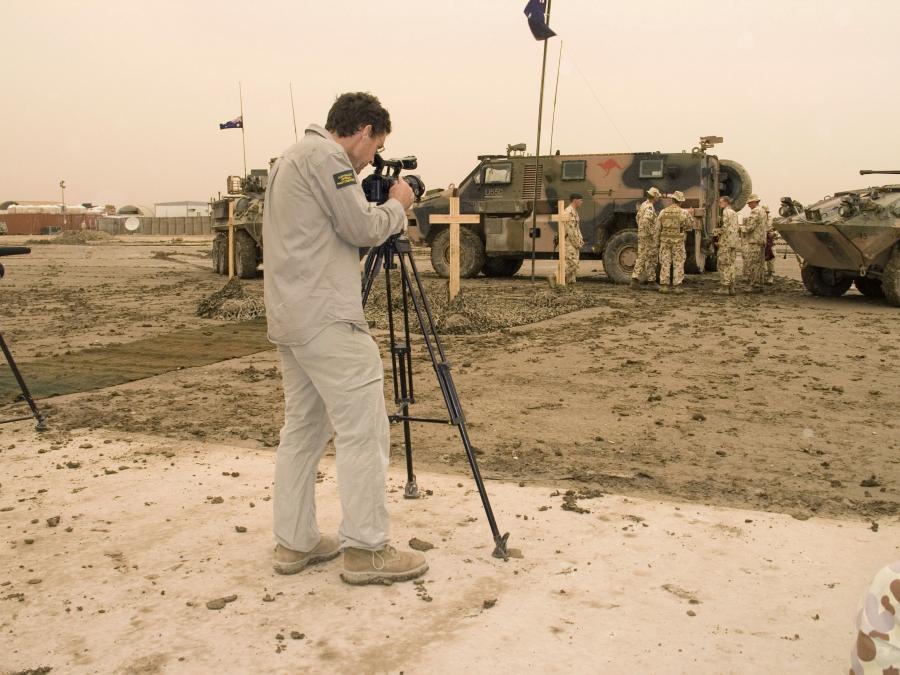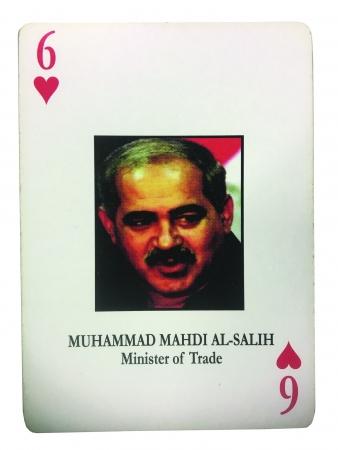Robert Nugent

The first official cinematographer, Robert Nugent, with his equipment inside his accommodation at Camp Smitty, Iraq, 2006. (AWM P05512.017)
Born in Albury, New South Wales, in 1958, Robert Nugent is an award-winning documentary filmmaker. He has filmed observational documentaries in remote parts of the world including in Guinea, Tanzania, Egypt, and Indonesia. Before becoming a filmmaker, he worked for the United Nations as a project manager and technical adviser in Afghanistan and Cambodia.[1]
In 2005 Robert was approached to become the Australian War Memorial’s first official cinematographer. The Memorial wanted to build on its collection of film footage, as film could record viewpoints that could not be captured in photographs or paintings. The Memorial was looking for someone who had a proven record of technical competence and artistic skill, could work individually, and communicated with people from all walks of life while demonstrating flexibility. The cinematographer would also need to undertake military training, and be prepared for long and irregular work hours with little sleep, and a lot of travel.[2]
After Robert accepted the position, he travelled to Sydney for a pre-deployment course. He learnt how to identify explosive devices, how to use a gas mask, and what to do if he got captured. Afterwards he travelled to Kuwait and Iraq to document the daily life of Australian Defence Force members who were part of Operation Catalyst, which came into effect after the US-led “coalition of the willing” invaded Iraq in 2003. The coalition was aiming to uncover weapons of mass destruction, and to end the rule of Saddam Hussein and his alleged links to terrorism. This became known as the Second Gulf War.
Even after Saddam Hussein was removed from power, fighting continued in the region as ethnic- and religion-based insurgency increased. The Australians serving in Operation Catalyst continued to work towards the stabilisation and security of the country. They undertook roles including the provision of security for Australian diplomatic and government personnel, and training of the new Iraqi armed forces. By the time the majority of Australian troops were withdrawn in 2009, more than 20,000 Australians had served in Iraq on land, in the sea, and in the air.
Robert wondered how the soldiers would respond to having a cinematographer around. He was working without a crew, and felt like the “new kid at school with everyone looking at me”.[3] When the company sergeant major for 3rd Battalion, Royal Australian Regiment (3RAR), introduced Robert to his soldiers, he told them: “Don’t worry about him; he’s not a journalist.”[4] This helped the soldiers to open up to Robert – he had been concerned that if the they viewed him as a journalist their words and behaviours would become sanitised. He wanted to record them exactly as they were.

Robert Nugent films Anzac Day service rehearsals in Iraq, 2006.
Robert got to know the Australian servicemen and servicewomen well, and came away from the experience with people he considered friends. He conducted more than 40 interviews, in which people would open up about their reasons for enlisting, their feelings on Iraq, the impact of weapons such as car bombs, and homesickness. He also recorded events including dawn patrols, meetings, training, meal times, leisure time, an Anzac Day ceremony, and service personnel communicating with loved ones back home in Australia. He experienced the same living and working conditions as the servicemen and servicewomen, including dangers such as missile attacks.
From his 75 hours of footage, Robert created a documentary called No dramas: recordings from Iraq, a phrase often used by the people he interviewed.[5] This film allowed soldiers to share their experiences in their own words, while also providing a visual journey across the landscape of Iraq. No dramas premiered in 2008, and was screened at the Canberra International Film Festival the following year.
After his deployment to Iraq, Robert again worked with the Australian War Memorial, travelling to Timor-Leste for two weeks in 2008. He documented the work of the Australian Defence Force, and also recorded the experiences of the civilian population.
Jon Cattapan, AWM cinematographer Rob Nugent (checking audio), 2008, pen on paper, 29.8 x 21 cm
Activities
- In addition to hours of film footage, Robert returned home with various souvenirs of his time in Iraq. He collected army and Air Force Exchange Service (AAFES) gift certificates such as the one below, which could be used to purchase goods at AAFES facilities.
- Visit the Australian War Memorial website and find examples of souvenirs from the First World War. Compare these to souvenirs from the wars in Iraq and Afghanistan.
- In what ways have these souvenirs changed or stayed the same over time?
- Robert also collected a pack of playing cards originally intended for troops serving on the ground in Iraq. These cards contained the images of the “most wanted” members of Saddam Hussein’s government. They were designed to be an “easily transportable intelligence product” that could educate service personnel in their leisure time.[6]
- In what ways do you think these playing cards could be more effective than a formal training manual?
- Saddam Hussein was shown as the ace of spades, with his sons the ace of clubs and hearts. What does this tell you about how the coalition viewed these men?
When the “Iraqi most wanted” playing cards were spotted on live television, the Pentagon in the United States received many requests for additional sets, including from the American President George W. Bush. With increasing public demand, the cards started being mass-produced. The United States Playing Card Company stated that they sold 750,000 sets in one week.[7]

Minister of Trade Muhammad Mahdi Al-Salih features on the six of hearts. He was captured in April 2003.
- Robert Nugent went to Iraq during the Second Gulf War, when the “coalition of the willing” aimed to overthrow Saddam Hussein’s regime.
- Find out which countries made up the “coalition of the willing”. Why do you think Australia joined the coalition?
- Find examples of protests from around the world disagreeing with the invasion of Iraq. Do you agree with the invasion? Why or why not?
- What happened to Saddam Hussein? Did the coalition locate weapons of mass destruction? The following sources may assist with your research:
- Extension: outline the differences between the First and Second Gulf Wars.
Related objects
Footnotes
[1] Australian War Memorial, “Cinematographers”, <accessed 25 September 2019>
[2] Australian War Memorial, “Cinematographers”, <accessed 25 September 2019>
[3] “No dramas: recordings from Iraq”, Robert Nugent (dir.), Australian War Memorial, 2008.
[4] Robert Nugent, “Waving to strangers”, Wartime 42, April 2008, p. 39
[5] Australian War Memorial, “No dramas – recordings from Iraq” page.
[6] Marjorie K. Eastman, “What the ‘Most Wanted Iraqis’ deck of cards can teach us about war”, <accessed 25 September 2019>.
[7] The United States Playing Card Company, “Our history”, <accessed 25 September 2019>.
Bibliography
Marjorie K. Eastman, “What the ‘Most Wanted Iraqis’ deck of cards can teach us about war” <accessed 25 September 2019>.
Robert Nugent, “Waving to strangers”, Wartime 42, April 2008, pp. 38–40.
Australian War Memorial, “Cinematographers” page, <accessed 25 September 2019>.
Australian War Memorial, “No dramas – recording from Iraq” page, <accessed 25 September 2019>.
Australian War Memorial, “Iraq 2003–2013” page, <accessed 25 September 2019>.
The United States Playing Card Company, “Our history”, <accessed 25 September 2019>.
Nola Anderson, “Treasures from a century of collecting”, Murdoch Books Australia, New South Wales, 2012, pp. 554–57.
BBC News, “Iraq’s most wanted – where are they now?”, 1 September 2010, <accessed 10 October 2019>.
Ronin Films, “Robert Nugent”, <accessed 17 October 2019>.

